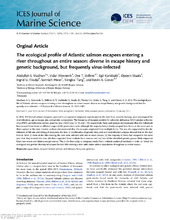| dc.contributor.author | Madhun, Abdullah Sami | |
| dc.contributor.author | Wennevik, Vidar | |
| dc.contributor.author | Karlsbakk, Egil | |
| dc.contributor.author | Skaala, Øystein | |
| dc.contributor.author | Fiksdal, Ingrid Uglenes | |
| dc.contributor.author | Meier, Sonnich | |
| dc.contributor.author | Tang, Yongkai | |
| dc.contributor.author | Glover, Kevin | |
| dc.date.accessioned | 2017-12-19T08:51:25Z | |
| dc.date.available | 2017-12-19T08:51:25Z | |
| dc.date.issued | 2017-05 | |
| dc.Published | Madhun AS, Wennevik V, Karlsbakk E, Skaala Ø, Fiksdal IU, Meier S, Tang, Glover KA. The ecological profile of Atlantic salmon escapees entering a river throughout an entire season: Diverse in escape history and genetic background, but frequently virus-infected. ICES Journal of Marine Science. 2017;74(5):1371-1381 | eng |
| dc.identifier.issn | 1054-3139 | en_US |
| dc.identifier.issn | 1095-9289 | en_US |
| dc.identifier.uri | https://hdl.handle.net/1956/17029 | |
| dc.description.abstract | In 2014, 129 farmed salmon escapees captured in an upstream-migration trap located in the river Etne, western Norway, were investigated for viral infections, age at escape, size, and genetic composition. The frequency of escapees positive for salmonid alphavirus (SAV), piscine orthoreovirus (PRV), and infectious salmon anaemia virus (ISAV) was 12, 79, and <1%, respectively. Fatty acid analysis demonstrated that the individuals had escaped from farms at different stages of the production cycle, although the majority had probably escaped from farms in the same year as their capture in the river. Genetic analyses demonstrated that the escapees originated from multiple farms. This was also supported by the distribution of fish size and timing of entry into the river. A combination of genetic, fatty acid and viral infection analyses showed that in the river Etne in 2014: (i) most of the fish entering the river were infected with one or more viruses, (ii) the majority of them had escaped in the same year that they entered the river, (ii) they originated from multiple farm sources, and (iv) two of the identified genetic groups likely originated from two recent and distinct escape events. This is the first study to integrate results from multiple analytical methods in order to reveal the ecological and genetic diversity of escaped farmed fish entering a river with native salmon population throughout an entire season. | en_US |
| dc.language.iso | eng | eng |
| dc.publisher | Oxford University Press | en_US |
| dc.rights | Attribution CC BY | eng |
| dc.rights.uri | http://creativecommons.org/licenses/by/4.0 | eng |
| dc.subject | Aquaculture | eng |
| dc.subject | escaped farmed salmon viral diseases | eng |
| dc.subject | fatty acid | eng |
| dc.subject | Genetics | eng |
| dc.title | The ecological profile of Atlantic salmon escapees entering a river throughout an entire season: Diverse in escape history and genetic background, but frequently virus-infected | en_US |
| dc.type | Peer reviewed | |
| dc.type | Journal article | |
| dc.date.updated | 2017-12-06T09:41:16Z | |
| dc.description.version | publishedVersion | en_US |
| dc.rights.holder | Copyright International Council for the Exploration of the Sea 2017 | en_US |
| dc.identifier.doi | https://doi.org/10.1093/icesjms/fsw243 | |
| dc.identifier.cristin | 1493477 | |
| dc.source.journal | ICES Journal of Marine Science | |

